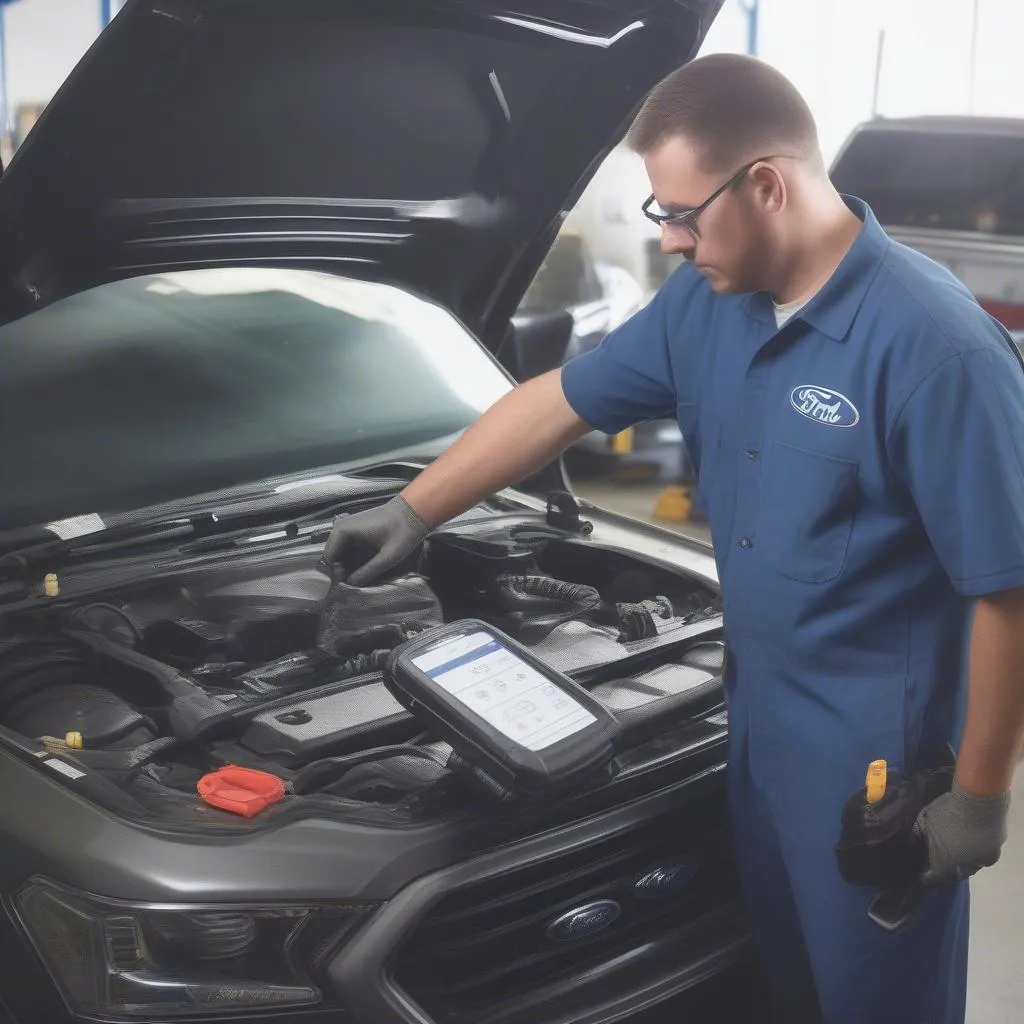Have you ever encountered the dreaded “check engine” light on your Ford vehicle? It’s a disconcerting sight that can fill any car owner with anxiety, especially when it’s accompanied by a P0401 code. This code indicates a problem with your Ford’s Exhaust Gas Recirculation (EGR) system. Don’t panic, though! Understanding the issue is the first step towards a smooth solution.
What Does Ford Obd Ii P0401 Mean?
From a mechanic’s perspective, the P0401 code signifies a malfunction in the EGR system’s ability to regulate the flow of exhaust gases back into the engine. The EGR system plays a crucial role in reducing harmful emissions by circulating a portion of exhaust gases back into the combustion chamber, lowering the combustion temperature and reducing NOx emissions.
From a technical standpoint, the OBD II system monitors the EGR system’s operation. The P0401 code is triggered when the Powertrain Control Module (PCM) detects a problem in the EGR flow, either being too high or too low.
From an economic standpoint, an EGR issue can lead to increased fuel consumption and potentially damage the engine if left unattended. It’s essential to address this issue promptly to ensure your Ford operates efficiently and complies with emissions regulations.
Diagnosing Ford Obd Ii P0401
The first step is to use a Ford OBD II scanner to confirm the P0401 code. This will allow you to see any other codes that might be present and help pinpoint the specific problem. You can use a generic OBD II scanner, but a Dealer Scanner For European Cars like the Launch X431 can provide more detailed information and diagnostic capabilities, which can be critical when diagnosing the P0401 code.
Let’s say you’ve received a P0401 code. What now? Several common causes could be the culprit, and it’s essential to investigate each one systematically:
Common Causes of Ford Obd Ii P0401
-
EGR Valve Problems:
- Sticking or faulty EGR valve: This is the most common cause of the P0401 code. The EGR valve regulates the flow of exhaust gases, and a faulty valve can restrict or prevent proper flow.
- Clogged EGR valve: Over time, carbon buildup can clog the EGR valve, hindering its operation.
- EGR valve position sensor malfunction: The sensor responsible for monitoring the EGR valve position can fail, leading to inaccurate readings and triggering the code.
-
EGR System Components:
- Clogged EGR tube or passageways: These can restrict exhaust gas flow and cause a P0401 code.
- Damaged EGR cooler: The EGR cooler cools the exhaust gases before they are recirculated. A damaged cooler can restrict flow or cause leaks, resulting in the code.
-
Other Causes:
- Vacuum leaks: Leaks in the vacuum lines that operate the EGR valve can disrupt its proper functioning.
- Damaged wiring or electrical connections: A faulty connection can interfere with the EGR valve’s operation and the PCM’s ability to monitor it.
- Engine vacuum issues: A lack of sufficient engine vacuum can also hinder the EGR valve’s operation.
Symptoms of Ford Obd Ii P0401
It’s not always a flashing check engine light that alerts you to a P0401 code. Other symptoms can also indicate an issue with the EGR system, such as:
- Reduced engine power: A malfunctioning EGR system can affect the engine’s performance, resulting in a noticeable drop in power.
- Rough idling: The engine might idle erratically, especially when the EGR system is active.
- Increased fuel consumption: A faulty EGR system can lead to inefficient fuel burning, increasing fuel consumption.
- Black smoke from the exhaust: A malfunctioning EGR valve can cause excessive black smoke, especially during acceleration.
Solutions for Ford Obd Ii P0401
Fixing the P0401 code depends on the underlying cause. Here’s a breakdown of potential solutions for each common issue:
EGR Valve Problems:
- Cleaning the EGR Valve: A clogged EGR valve can be cleaned with a specialized cleaner, restoring its proper function.
- Replacing the EGR Valve: If the valve is damaged or worn out, replacing it with a new one is necessary.
EGR System Components:
- Cleaning the EGR Tube and Passageways: Accumulated carbon can be removed from these components using specialized tools and cleaners.
- Replacing the EGR Cooler: A damaged EGR cooler should be replaced to ensure proper cooling and prevent leaks.
Other Causes:
- Repairing Vacuum Leaks: Identifying and repairing any leaks in the vacuum lines is crucial for restoring proper EGR operation.
- Inspecting and Repairing Wiring and Electrical Connections: Faulty connections need to be repaired or replaced to ensure proper communication and control.
- Addressing Engine Vacuum Issues: Check for any engine vacuum issues and rectify them to ensure the EGR valve operates correctly.
Troubleshooting Tips:
- Inspect for visual damage: Look for any visible damage or cracks in the EGR valve, EGR tube, or other related components.
- Check vacuum lines: Ensure the vacuum lines are connected securely and free of leaks.
- Test the EGR valve: With the engine running, disconnect the vacuum line to the EGR valve. If the engine RPM drops, the EGR valve is likely working. If the RPM doesn’t change, the valve might be stuck open or closed.
- Use a diagnostic scanner: As mentioned earlier, a Dealer Scanner For European Cars can provide more detailed information about the EGR system’s operation and help pinpoint the problem.
Common FAQs
Here are some frequently asked questions about Ford Obd Ii P0401:
Q: Can I drive my Ford with the P0401 code?
A: While driving with a P0401 code is technically possible, it’s not advisable. It can lead to increased fuel consumption, reduced performance, and potential engine damage if left unaddressed.
Q: How much does it cost to fix a P0401 code?
A: The cost of repair depends on the specific cause and complexity of the issue. A simple EGR valve cleaning might cost around $100, while replacing the EGR valve could range from $200 to $500, depending on the model and year of your Ford.
Q: Can I reset the P0401 code myself?
A: While you can reset the code using a scanner, it will only temporarily clear the check engine light. The underlying issue needs to be addressed to prevent the code from recurring.
Get Expert Help
If you’re not comfortable diagnosing and fixing the P0401 code yourself, it’s best to consult a professional mechanic specializing in Ford vehicles. They can use their expertise and specialized tools to diagnose the issue accurately and provide the right solution for your Ford.
Remember, if you’re facing a P0401 code, it’s crucial to address it promptly. Ignoring the problem could lead to more significant issues and costly repairs down the line.
Let’s Connect
If you’re struggling with Ford OBD II codes, including P0401, or need help with diagnostics or repairs, feel free to contact us! We are here to help you troubleshoot your Ford’s electrical systems and keep your car running smoothly. You can connect with our team of experts via Whatsapp: +84767531508, available 24/7.
 EGR valve repair
EGR valve repair
 Ford OBD scanner
Ford OBD scanner
 Ford check engine light
Ford check engine light
For further information on Ford OBD II codes, you can also check out our other articles on:
- 2004 F150 OBD Codes
- 1996 Ford F150 OBD Codes
- Is Ford Escape 2004 OBD II Certified?
- Ford F150 Eddie Bauer 1996 OBD Codes
- EGR OBD Codes
Let us know your experience with the P0401 code and feel free to leave any questions or comments below. We’re here to help!